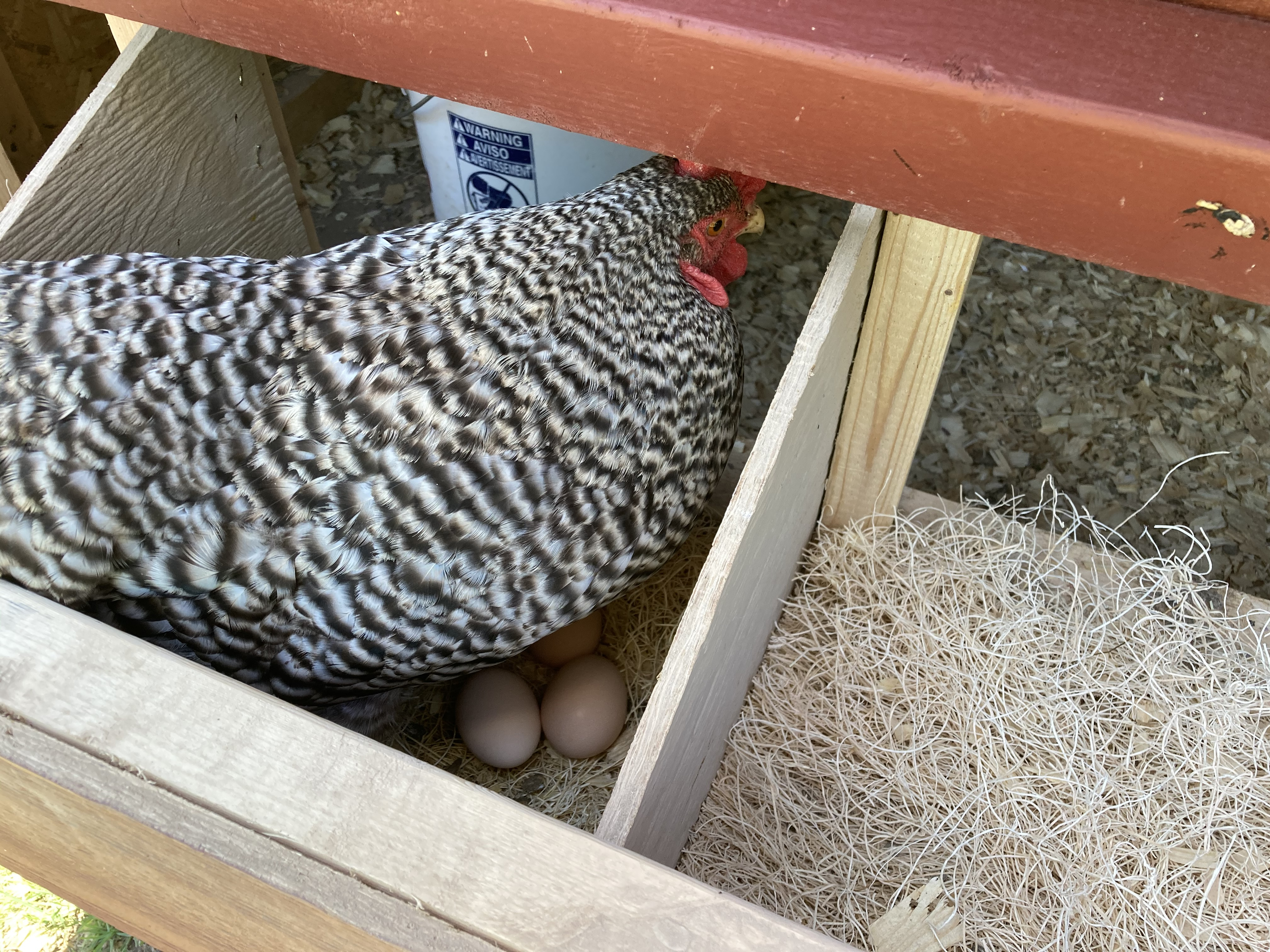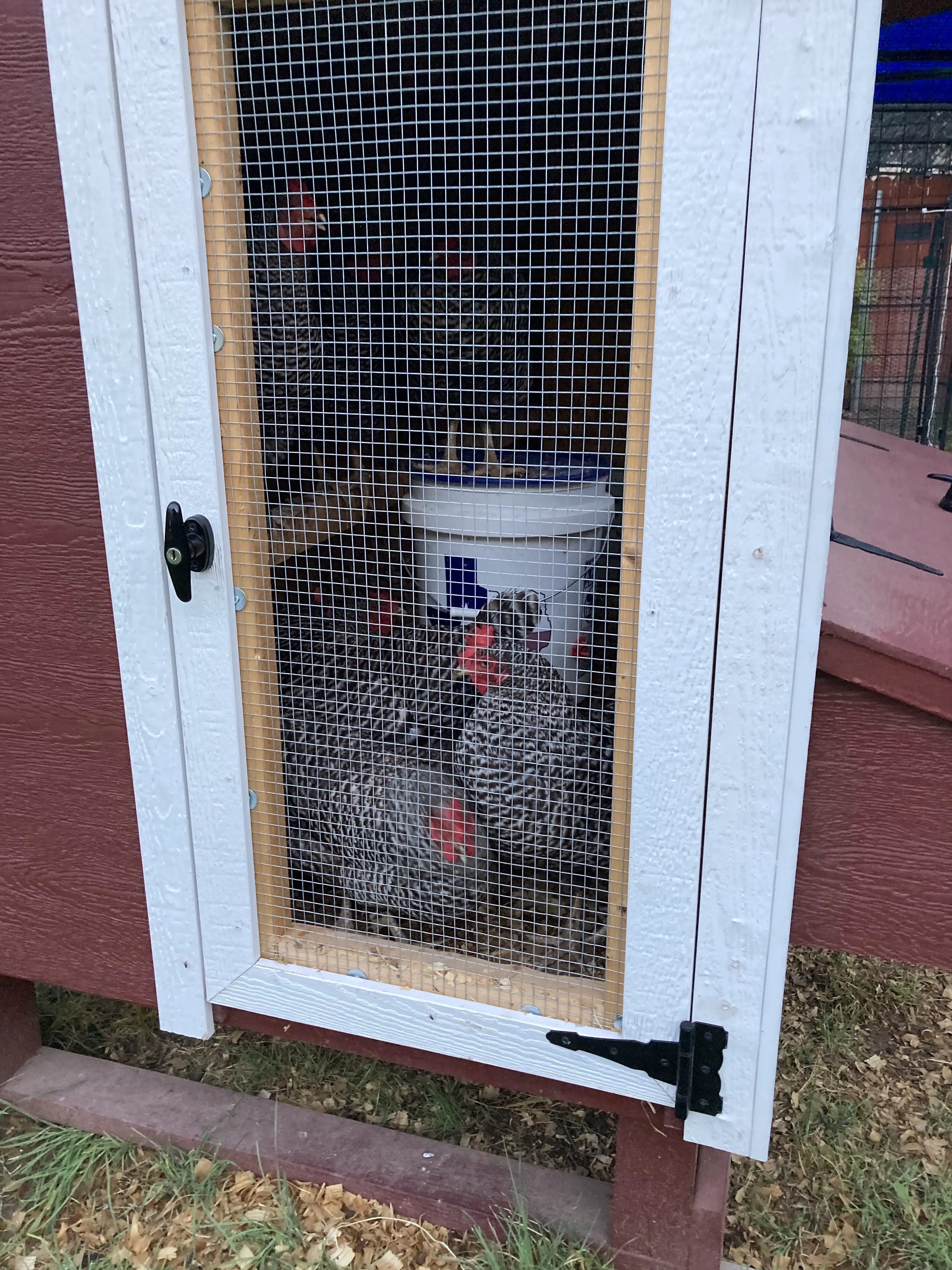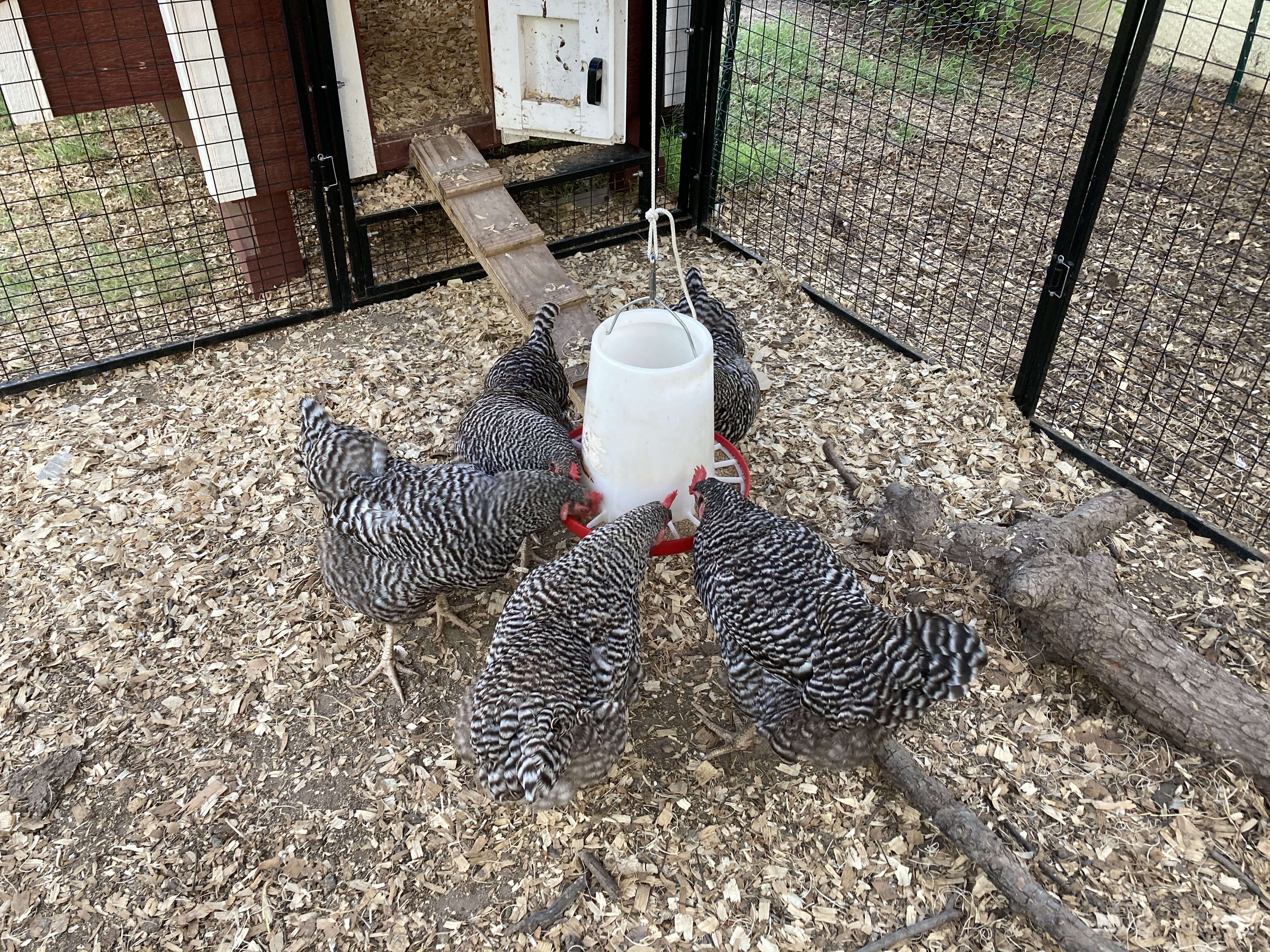When planning your chicken coop design or deciding which kit to purchase, there are a few items that you need to make sure are included in the coop for the health and wellbeing of your chickens.
The inside of the chicken coop should contain roosting bars, nesting boxes, adequate bedding, and proper ventilation. Items that are optional for inside a chicken coop include waterers and feeders. Items that should never be inside a chicken coop are toxic chemicals or anything that can start a fire.
Keep reading to learn more about the items that should be inside the chicken coop and how they will contribute to your flock’s health and wellbeing.
Note: This list of items only applies to chicken coops and not to chick brooders. For more about chicks, read What to Feed Baby Chicks After Hatching. In addition, this post is assuming that you already have sufficient space inside the chicken coop. Check out Space Requirements for Your Backyard Chickens for more about the space needed inside a chicken coop.
✅ Roosting Bars
Chickens need roosting bars because this is where they sleep at night.
Before chickens were domesticated, they would sleep in the trees in the jungles of Southeast Asia. By sleeping in trees, chickens would be protected from ground predators and the canopy of the trees would give them protection from aerial threats.
At the end of the day as it starts to get dark outside, chickens will naturally make their way to their coop and hop up on their nesting bars. Your chickens should easily be able to jump onto the roosting bars. If a chicken is injured, older, or too heavy, she might have difficulty jumping onto roosting bars that are too high off the ground.
Roosting bars should be no more than 2 feet off the ground. If they are much higher than that, there should be a lower roosting bar that the chickens can jump onto first and then jump on the roosting bar.

Typically, the roosting bars should meet these lengths for different types of chicken breeds:
| Breed | Roosting Bar (length) |
| Regular | 8″ per chicken |
| Heavy | 10″ per chicken |
| Bantam | 8″ per chicken |
For example, if you have 5 Buff Orpingtons you will need 50 inches of roosting bars in the chicken coop. I would recommend trying to have that in one length (instead of two bars at 25 inches each). My chicken coop has 2 roosting bars, but all the chickens prefer to sleep on the top bar. Chickens lower in the pecking order will not get the highest spot since this would be the safest spot in the wild and would be taken by the chickens higher in the pecking order.
You might notice there will be a bit of squabbling as chickens select their roosting bars because they each have a preferred location on the roosting bars. After they are positioned in their spot for the night they will not make any more noise until the sun comes up in the morning.
✅ Nesting Boxes
Nesting boxes are important for a chicken coop because this is where the chickens will lay their eggs during the day.
You should have at least 1 nesting box for every 4 to 5 chickens. Even if you have enough nesting boxes, the chickens will typically claim one box as the preferred box and this preferred box can rotate to different boxes in the coop.
The reason why chickens will choose to lay their eggs in one box is because they view a pile of eggs as a safe place for them to also lay their own eggs. You can encourage hens to lay in different nesting boxes by adding wooden eggs into the nesting boxes. It also helps to regularly remove eggs that have been laid to prevent the chickens from congregating in one box for too long which can lead to broken eggs.
A nesting box should be large enough for a chicken to sit in the box and comfortably lay an egg. If it’s too large, some hens don’t feel like it’s secluded enough and will seek out a more private nesting location elsewhere. Some chickens will lay eggs in the yard under bushes or other secret places if they don’t feel comfortable in their nesting boxes. To learn more about why chickens lay eggs in the yard, read 12 Reasons Why Chickens Lay Eggs in the Yard.
In general, a nesting box should meet these size requirements:
| Type of Breed | Nest Box Dimensions (long x high x deep) |
| Regular | 12″ x 12″ x 12″ |
| Heavy | 14″ x 14″ x 12″ |
| Bantam | 10″ x 12″ x 10″ |

Nesting boxes should be appropriately sized for the type of chicken breed that you are raising so take this into consideration when you are building or buying your chicken coop. Most chicken coop kits or instructions for building coops online will give you the nesting box dimensions, so just check them against the table above and you should be good.
✅ Bedding
Bedding is necessary for a chicken coop for several reason:
- Keeps coop clean from droppings
- Provides soft landing for chickens jumping off roosting bars
- Can be used in nesting boxes
- Protects wooden floor of chicken coop
In Types of Bedding for Chicken Coops, I discuss the various types of bedding for coops. I use pine shavings as bedding in my chicken coop. Pine shavings are a great type of bedding, although there are several other options.
The main benefits of pine shavings is that they are easy to transport, relatively inexpensive, do not cause any respiratory issues for chickens, and do not require a lot of additional maintenance for a chicken coop.

When adding bedding, make sure there is 2 to 3 inches of bedding in your chicken coop. This will capture any droppings from the chickens, which helps to control the odor in the coop. In addition, the pine shavings will help deter flies from swarming the chicken coop since the shavings soak up any droppings. To help cover the droppings, toss some scratch grains or sunflower seeds into the coop after adding new bedding to let the chickens scratch around and mix in the new bedding.
Another benefit of bedding is that is provides a soft landing for chickens as they jump off their roosting bars in the morning. Their bodies are very top heavy for their little legs and when they hit the floor of the chicken coop it can sound like someone dropped an 8 pound bowling ball. The bedding can also serve as a type of carpet to dry their feet when they come in from the mud. This is helpful for preventing them from tracking mud into the nesting boxes and getting it on freshly laid eggs. Check out 5 Reasons For Dirty Eggs in the Nesting Box for more reasons why eggs can get dirty after they are laid.
Bedding can also be used in nesting boxes. Nesting boxes need some type of covering to provide a soft landing for eggs as they are laid. Some chickens will peck at the bedding and adjust it to make it just right before they lay.
While pine shavings can be used in a nesting box, I prefer to use nesting pads which I describe in my Recommendations.
Many chicken coops have wood floorings which can be damaged from chicken manure or leaking water from a waterer inside the coop. The bedding helps to protect the floor and prolong the life of your chicken coop.
Bedding is an important item to include in your chicken coop, not only for your chickens and their wellbeing, but also for maintaining the chicken coop.
✅ Ventilation
Ventilation is likely the most important aspect of any chicken coop design.
Chickens have a sensitive respiratory system and require constant air flow to ensure good health. A respiratory illness in a chicken can be caused by dust, ammonia (from excessive manure), and too much moisture in the air, which is why ventilation is so critical.
The interior of the chicken coop should allow for adequate air flow from one end of the coop to the other, including the nesting boxes. You can determine if a coop has enough ventilation by following the 3 tests described in The Most Important Aspect of a Chicken Coop.
If there is even a faint smell of ammonia, you probably need to add more ventilation. High levels of ammonia in a chicken coop can cause “ammonia burn”, or conjunctivitis in chickens that can lead to blindness. Ammonia odor is caused by unsanitary conditions, such as excess manure in a coop.
In general, to maximize ventilation in a chicken coop, or any other structure, there are some basic principles to follow. The amount of air that is moved through a structure will be directly proportional to the size of your air inlets and outlets. Make sure you open at least two windows at opposite ends of the structure to get a benefit from the cross breeze.
The Most Important Aspect of a Chicken Coop also includes tips to increase ventilation in your existing coop, such as replacing the coop door with a screen door and adding ventilation holes near the ceiling.

⚠️ Waterers
An optional item to include in your chicken coop is the waterer.
Chickens will not wake up in the middle of the night to get water and will only drink when there is light outside. If you are consistent about letting the chickens out in the morning at the first light, there should be no issues by not having water for your chickens in their coop.
The waterer can be a good item to include in your coop if your chickens spend a significant amount of time inside the coop during the day (for example, during the winter). I have a waterer in my coop so the hens that go in to lay have access if they need a drink, but this is probably not necessary since they have a waterer in their run just a few steps away.

If you do leave the waterer in the coop, make sure to periodically check to make sure that water is not dripping into the bedding or the ground below the waterer. This wet area can be a perfect breeding ground for flies and other insects.
If flies are a problem in the chicken coop, consider removing the waterer from the coop altogether. Since flies are attracted to stagnant water, the fresh water for your chickens that is changed daily will not be an issue; any eggs or larvae will be rinsed out daily.
⚠️ Feeders
Feeders are another optional item that you can include in your chicken coop.
I would suggest having a feeder in the coop if your chickens spend a significant amount of time inside the coop during the day, similar to the waterer.
However, there are several reasons why it’s better to not include the feeder in the coop:
- Coop can get too hot
- Attracts pests
- Takes up space
Especially during the summer, you don’t want your chickens spending a lot of time inside the coop because it can get very hot. If you have many chickens in a small area, their body heat will increase the temperature of the coop. During hot weather, it’s best to place the feeder in the run to encourage the chickens to get out of the hot coop.

Another reason to not have the feeder in the coop is because it can attract unwanted pests in the coop that can be difficult eradicate. Mice, rats, and raccoons are some of the pests that are attracted to chicken feed. Once they have found an easy meal, they will be back daily.
At night, the feeder should be removed from the run and put up away from any pests. Chickens will not eat in the middle of the night so you don’t need to worry about them getting hungry.
A feeder in the coop will also take up space that is better suited for your chickens. Unless you have a large walk-in coop, you probably don’t have enough space for the feeder plus the space around the feeder to allow the chickens access to the food. When the feeder is in the run, your chickens should have plenty of space to gather around the feeder and eat without it being a wrestling match.
In general, I would not recommend a feeder inside the chicken coop unless your chickens spend a significant amount of time inside the coop during the day and you have sufficient space for the feeder and the chickens to eat.
⛔️ Pesticides and Other Chemicals
Items that should never be inside a chicken coop include pesticides and any other chemicals.
Pesticides are dangerous for chickens. Since chickens peck the ground to look for food, you don’t want them to accidentally peck a pesticide pellet or eat a bug that has been poisoned.
A non-toxic alternative to pest control in the coop is diatomaceous earth (DE). DE is essentially fossilized crystals that cut the exoskeleton of bugs, causing them to die from dehydration. This white, powdery substance is safe for chickens and can even be added to chicken feed a few times a year as a worm preventative.
As mentioned earlier, chickens have sensitive respiratory systems and any chemical odors can cause them to get ill. When cleaning out their coop, make sure to use non-toxic cleaners, like vinegar or alcohol. Or better yet, just use a bit of elbow grease and warm water.
⛔️ Sources of Fire
Chicken coops are generally made of flammable materials (wood) and contain bedding that can be easily ignited. Avoid all sources of flame or fire around your chicken coop.
A source of heat is not needed inside the chicken coop. Chickens are able to handle cold much better than they can handle heat. Chickens have an internal temperature of 106 degrees F and they keep warm by huddling together. You will also see a cold chicken raise one leg up into her fluffy feathers. By standing on one leg, she is decreasing the amount of her body that is exposed to the cold and is able to stay warmer.
During cold weather, make sure that there are no drafts blowing through the chicken coop. Chickens absolutely need ventilation in their coop, but they don’t need a frigid arctic breeze blowing in their coop. Chickens that have larger combs or wattle are at increased risk of frost bite, so be particularly aware of that during excessively cold weather.
If you are concerned about your chickens being cold during the winter, add more bedding to their coop. Chicken keepers that use the deep litter method will tell you that this will warm up the chicken coop as the bedding is being turned into compost, which gets very hot inside the pile of bedding. You can also place straw bales around the outside of the coop to serve as a natural insulator.
In summary, the items that should be inside every chicken coop include:
- Roosting bars
- Nesting boxes
- Bedding
- Adequate ventilation
Items that are optional to include inside a chicken coop include:
- Waterer
- Feeder
Things that should never be inside a chicken coop are:
- Toxic chemicals, including pesticides
- Sources of fire


